17 Types of Pencils Designed Specifically for Your Art
Author: Jen Worst | Editor: Omar Alonso
Review & Research: Jen Worst & Chris Miller

Today, millions of people use different types of pencils in dozens of sectors of their lives. Modern pencils owe their existence to a Roman invention called the stylus.
After discovering a massive graphite deposit in Borrowdale, England, in the sixteenth century, graphite became widely used as a replacement for the stylus. And that way modern pencil was born.
The market for pencils is ever-growing all the time. Even in recent times, the sales of pencils grew from the previous year.
Now there are different types of pencils available for various purposes. We are almost certain that many of us don't know how many variations of the pencil are currently present in the world. In this article, we will discuss the exciting world of pencils and talk about their uses.
17 Types of Pencils
Not only for educational purposes and making art, but we also use pencils in so many aspects of our lives. We will inform you in this article about the variations of the pencils.
Graphite Pencils

Graphite pencils are the most commonly used pencils everywhere. They have a wood case and a mixture of soft graphite and clay at the core. The ratio between the graphite and the clay makes different graphite pencils that are distinguishable from one another.
If a graphite pencil has more graphite than clay, the pencil will become softer and produce darker marks. As far as types of drawing pencils go, these can offer precision or let you sketch more quickly to get ideas down first.
And if one of these drawing pencil types has more clay than graphite, the pencil will become harder and produce lighter marks. Based on the amount of graphite and clay, these graphite pencils offer a range from 9H to 9B on the pencil degrees of hardness scale.
H means it has more clay, and the pencil is harder and creates lighter marks. B means the amount of graphite is greater, and the pencil is darker and softer.
You can erase or rub graphite marks from paper with an eraser. These pencils have many uses. One can draw, sketch, or even take notes with them. Despite being your basic, commonly available writing utensil, they're also among the best types of sketching pencils.
Charcoal Pencils

Charcoal pencils can fabricate high contrast and rich tones in different arts. They are skilled at implementing detailed and photorealistic drawings. For certain styles of art, these are the main types of pencils for drawing, especially if you fill in lots of shading.
Most of them come in black, but some are also white. There are some sepia tones available as well. Solid charcoal pencils are quite messy, unlike wooden-covered and paper-wrapped charcoal pencils.
The marks left by charcoal pencils are also easy to erase or remove from plain paper. But if the paper has a rough texture, the charcoal is more likely to adhere to that surface. Charcoal pencils are also frailer than other pencils. In their drawings, many great artists used charcoal pencils.
Besides drawing and sketching, smudging can be done with a charcoal pencil. Though these types of pencils are popular for their rich, bold tones, they can also create a thin, fine line in art.
Carbon Pencils

Carbon pencils are known for their darker impact than graphite and are also smoother than charcoal pencils. They are harder to erase because of their magnificent texture and high-quality blending. Carbon pencils are made from clay and have a kind of black pigmentation.
Their range of darkness is maintained with the mixing of graphite and charcoal into their core. These are another of the types of pencils used for sketching and shading, acting as a hybrid between the two mentioned ones.
They normally have wooden packaging on the outside. The sketches made from carbon pencils create more expression. As they are softer than graphite pencils, one needs to be more gentle while sharpening them.
Grease Pencils

The grease pencil is a unique piece of equipment. It is also known as wax pencils, as it has a core of solid-colored wax wrapped in a paper casing.
In some places, especially in the middle of Europe, they are also known as the China marker or Chinagraph pencil. They are famous for their ability to mark on any hard, shiny, and non-porous surface.
Grease pencil can create its mark on glass, rock, plastic, polished stone, porcelain, metal, glossy papers used for photographic printing, x-rays, glazed surfaces, lacquered or polished surfaces, and analog audiotapes, films, etc.
The implementations of grease pencils are many. From a formal laboratory to a construction site, a grease pencil is extremely helpful for marking in extreme conditions.
Chemists, construction workers, and handypersons use wax pencils in their workstations because of their efficacy. These different pencil types for drawing are used for that purpose, but on other surfaces than just paper.
These grease pencils leave marks without getting a scratch on the surface. Even on a wet surface, it can work perfectly.
Watercolor Pencils

Another name for the watercolor pencil is the water-soluble pencil. A special substance is used to make the core of the watercolor pencil. The marks from the material get dissolved in water, at which point you can consider watercolor one of the types of paint though some consider it one of the paint alternatives.
A watercolor pencil works both as a traditional dry-colored pencil and a watercolor. We can even use both effects in any art form. These types of pencils are pretty versatile.
The implementation of these pencils is different from regular ones. First, you have to use the dry pigment as necessary and then take any wet types of paint brushes to get the desired watercolor effect.
Artists can use a paintbrush to mix one color with another. To spread and intensify the color, the use of a paintbrush is necessary. A professional-grade watercolor pack can have up to 120 colors. But it all starts with having a pack of these types of art pencils.
Mechanical Pencils

Mechanical pencils are the most similar to ballpoint pens. The mechanical pencil mechanism works by pushing through a lead to write or draw on paper. It usually has a metal or plastic frame.
We can use refillable graphite leads as cartridges. The leads have a precise diameter to be used on specific pencils.
These graphite leads are similar to regular graphite pencils. It comes in a variety of shades. These are always worth having in your pen cup on whatever types of desks you have at home or at the office.
The leads are usually very thin. That's why it can mark very thin lines with precision. This type of pencil is mostly used in technical drawing.
Stenographer's Pencils

A stenographer's pencil is a specialty pencil. These workers write quickly and can't miss or waste a single moment, though they now use special typewriters rather than writing by hand. Stenographers need a reliable pencil that won't break in the middle of their writing. A stenographer's pencil is made of a solid, uniform, and unbreakable core.
Golf Pencils

The name "golf pencil" can be misleading, as they don't limit themselves only to one sector of use. Golf pencils are as compact as possible to suit a player's score-keeping demands while taking up as little space as possible.
It's also especially well-suited to tiny hands that are learning to write. Golf pencils are commonly used at churches and libraries, gas stations for lottery tickets, restaurants, weddings, other occasions, etc.
Solid Graphite Pencils

Solid graphite pencils are similar to normal graphite pencils, just without the wood casing. Artists use these types of pencils more often than any other for the bulk of their work.
Liquid Graphite Pencils

A liquid graphite pencil is just a pencil where liquid graphite is used rather than solid graphite. It is used inside of a pen to make the ink erasable. These are possibly the most unique among the different kinds of pencils.
Pop-a-Point Pencils

In the late twentieth century, pop-a-point pencils were extremely popular. Because each pencil barrel is loaded with numerous pre-sharpened pencil points, these pencils never need to be sharpened.
You pull the point out of the bottom when it becomes dull, then slide the plastic tip holder into the top of the plastic pencil barrel.
Plastic Pencils

Plastic pencils are unbreakable and can be bent. They're manufactured from a plasticized graphite mix and a wood-composite core comprised of ABS plastic, wood flour, and aluminum stearate that's co-extruded.
Pencil Crayons

Pencil crayons are also known as coloring pencils or colored pencils. Widely used by children and artists all over the world. A color pencil has a wax-based core with different colored pigments mixed with oil-based additives and binding agents.
Carpenter's Pencils

Carpenter's pencil is made of strong graphite, and they tend to be durable. The shape of this pencil is not round. That's why it doesn't roll from its place and fall easily.
Non-Reproducing Pencils

Non-reproducing pencils are also called non-photo blue pencils. These are specialized types of pencils, and their mark can't be photocopied. These pencil types are normally used for important government plans and important documents.
Copying Pencils

Copying pencils are just the opposite of non-producing pencils. It has a special color pigment in its core, which can act like a normal pencil. But when you add water and press another paper on it, the markings will be copied to that paper.
Eyeliner Pencils

Eyeliner pencils are wax-based pencils specially made for makeup. They are generally used by makeup artists and other people who want to beautify their eyes.
It is easily removable from the skin, making it very popular among people who like to wear makeup.
Types of Pencils Perfect For Your Art
Whatever your requirements are, from a solid graphite pencil to a mechanical pencil, we hope you now have a good idea of their uses and advantages.
Depending on our needs, almost everyone uses a pencil or will be using a pencil at some point. The variety of different types of pencils makes our lives easier. Who would have thought there were so many different pencil types out there?



